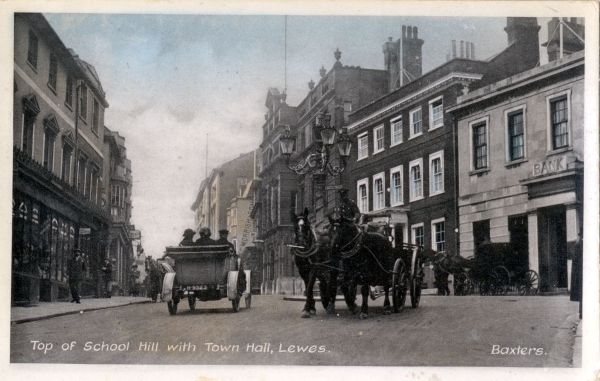W. E. Baxter Ltd.

Top of School Hill, Lewes, before the War Memorial was built in the early 1920s (a feebly coloured R.A. Co. card).
Stationers and printers, 35 High Street, Lewes. In around 1915 Baxters published the Brew Series of at least 22 quality real photographic cards of Lewes and district, including views at Offham, Barcombe Mills, Glynde and Kingston (the famous six sail windmill). The firm's name "Baxters" can also be found on the front of some glossy surfaced but anaemically coloured collotype cards of Lewes that were printed by Radermacher, Aldous & Co. of East London (see above). In addition, F. Frith & Co. Ltd. of Reigate produced some sepia-tinted and coloured collotype cards of Lewes that claimed on the back to be "Published by W.E. Baxter Ltd., 35 High Street, Lewes", but nevertheless were prominently labelled "Frith's Series". Baxters also sold a booklet of six tear-out collotype cards of Lewes, which as printers they could possibly have manufactured themselves. The booklet cost a mere three pence!
Towards the end of the Edwardian era Baxters are believed to have opened a short-lived branch at Steyning - several collotype cards of Steyning are known (1908 postmark seen) marked "W.E. Baxter Ltd., Steyning & Lewes".
Following publication of the Brew Series, Baxters of Lewes appear to have ceased postcard production for about half a century, though they retained their High Street shop and nearby printing works. Then in the 1970s or 1980s they published a selection of coloured cards of Glyndebourne garden and the celebrated opera house, presumably to special order.
The Baxter family is believed to have originated in Surrey. After training in London, John Baxter (1781-1858) settled in Lewes and set up a printing press on School Hill in 1802. He invented a composition inking roller, which proved to be a major technical advance, and published a wide variety of books, including the illustrated "Baxter" Bible and Horsfield's History of Lewes. In 1837, together with his youngest son, William Edwin Baxter, he launched the highly successful Sussex Agricultural Express, which continues today as the Sussex Express. William edited the paper for many years and succeeded his father as proprietor.
Of John Baxter's three sons, the best known was George (1804-1867), who moved to London in 1827 and became a celebrated engraver and colour printmaker. George invented an elaborate process of printing using a succession of engraved metal plates and wood blocks to transfer oil paints to paper. The resulting "Baxter Prints" are keenly collected today.
William Baxter, who was born in about 1808 or 1809, lived in Lewes High Street. His wife, Anne, came from Shropshire. One of their sons was Wynne Edwin Baxter, who was born in 1844. By 1881 Wynne was working as a solicitor in Lewes, and over the years he built up a very successful business. He and his wife, Kate, lived at 208 High Street. Ten years later he had remarried and with his new wife Caroline was living at 9 Albion Street.
The Baxter printing works in Lewes remained in use until quite recently but have now been replaced by flats.
To directory of publishersTo gallery
Design: Lucid Design
© www.sussexpostcards.info
